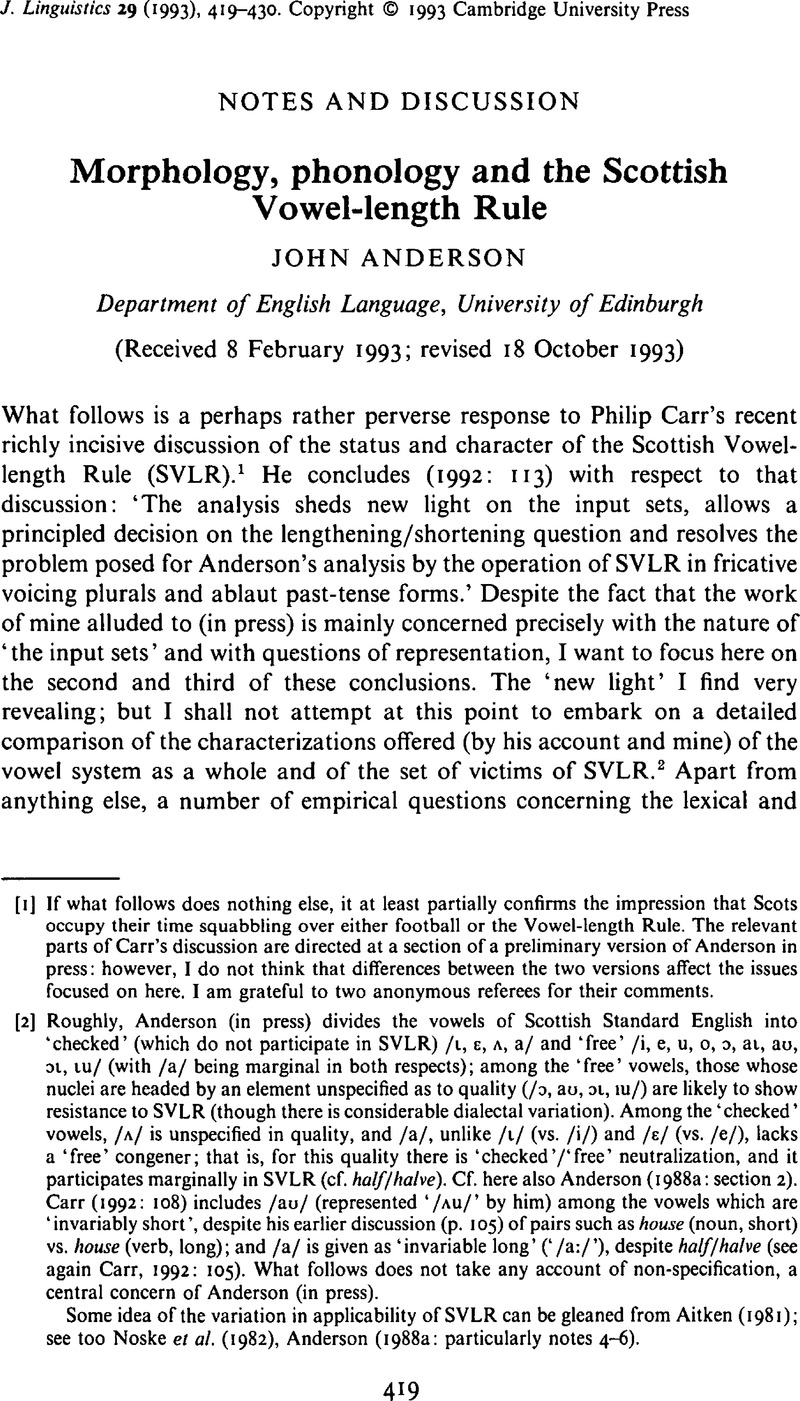No CrossRef data available.
Article contents
Morphology, Phonology and the Scottish Vowel-length Rule
Published online by Cambridge University Press: 28 November 2008
Abstract
An abstract is not available for this content so a preview has been provided. Please use the Get access link above for information on how to access this content.

- Type
- Notes and Discussion
- Information
- Copyright
- Copyright © Cambridge University Press 1993
References
REFERENCES
Aitken, A. J. (1981). The Scottish vowel-length rule. In Benskin, M. & Samuels, M. L. (eds.) So meny people, longages and tonges. Edinburgh: Benskin & Samuels. 131–157.Google Scholar
Anderson, J. M. (1986). Suprasegmental dependencies. In Durand, J. (ed.) Dependency and non-linear phonology. London: Croom Helm. 55–133.Google Scholar
Anderson, J. M. (1988a). System geometry and segment structure: a question of Scots economy. NELS. 18 22–37.Google Scholar
Anderson, J. M. (1988b). Old English ablaut again: the essentially concrete character of dependency phonology. In Duncan-Rose, C. & Vennemann, T. (eds.) On language: rhetorica, phonologica, syntactica. A festschrift for Robert P. Stockwell from his friends and colleagues. London: Routledge. 161–182.Google Scholar
Anderson, J. M. (1992). Linguistic representation: structural analogy and stratification. Berlin: Mouton de Gruyter.CrossRefGoogle Scholar
Anderson, J. M. (in press). Contrastivity and non-specification in a dependency phonology of English. Studia Anglica Posnaniensia 26.Google Scholar
Anderson, J. M. & Ewen, C. J. (1987). Principles of dependency phonology. Cambridge: Cambridge University Press.CrossRefGoogle Scholar
Carr, P. (1992). Strict cyclicity, structure preservation and the Scottish vowel-length rule. JL. 28 91–114.CrossRefGoogle Scholar
Colman, F. (1985). On some morphological formatives in Old English. Folia Linguistica Historica. 6 267–283.Google Scholar
Colman, F. (1987). The phonology and morphology of an Old English digraph: ie. In Anderson, J. M. & Durand, J. (eds.) Explorations in dependency phonology. Dordrecht: Foris. 49–77.Google Scholar
Colman, F. (1991). Money talks: reconstructing Old English. Berlin: Mouton de Gruyter.CrossRefGoogle Scholar
Halle, M. & Mohanan, K. P. (1985). The segmental phonology of Modern English. Lin. 16 57–116.Google Scholar
Harris, J. (1989). Derived phonological contrasts. In Ramsaran, S. (ed.) Studies in the pronunciation of English: a commemorative volume in honour of A. C. Gimson. London: Croom Helm. 87–105.Google Scholar
Kaisse, E. & Shaw, P. (1985). On the theory of lexical phonology. Phonology Yearbook. 2 1–30.CrossRefGoogle Scholar
Kiparsky, P. (1982). From cyclic to lexical phonology. In Van Der Hulst, H. & Smith, N. S. H. (eds.) The structure of phonological representations, vol. I. Dordrecht: Foris. 131–175.Google Scholar
McMahon, A. M. S. (1991). Lexical phonology and sound change: the case of the Scottish vowel-length rule. JL. 27 29–53.CrossRefGoogle Scholar
Noske, R. G., Schinkel, J. & Smith, N. S. H. (1982). The question of rule ordering: some counter fallacies. JL. 18 389–408.CrossRefGoogle Scholar
Wells, J. C. (1982). Accents of English, vol. II: The British Isles. Cambridge: Cambridge University Press.Google Scholar




